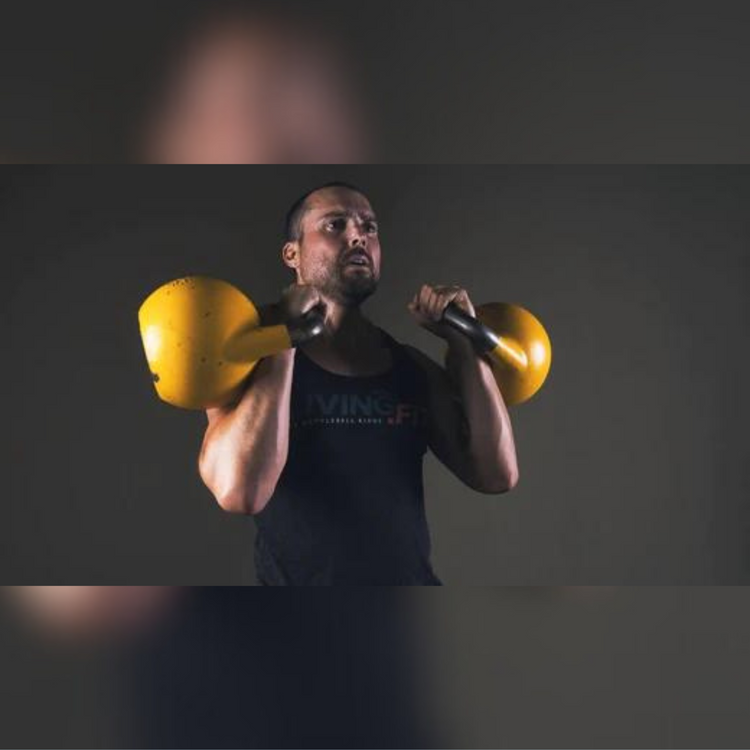Three Ways to Program Kettlebells

The simplicity of the kettlebell can’t be beat. I love the idea of grabbing a bell or two, finding a park with a pull up bar and getting to work. With a couple of kettlebells you can do just about anything except change the weight of the bell. Most people have access to a bell or two (or three if you’re REALLY lucky), but few have access to a rack of kettlebells as you’d see with dumbbells. Let’s say you take a lesson or a course and fall in love with kettlebell training. You find a bell, start progressing, but then there’s a gap between getting your next bell.
What to do?
In order to get stronger you need to adhere to the principle of Progressive Overload. With a bar or dumbbells, it’s fairly easy to add another 5lbs every few sessions, but that’s not going to work with the kettlebell.
When I first started I only had access to a few bells so out of necessity I tried progressing in different ways. Little did I know that these were actually extremely useful even when I had a smorgasbord of bells. As I’ve said multiple times make sure you focus on quality movement. Perfecting your technique of even simple exercises will take you further and is rarer than you think. Progressing can also come in the form of performing an exercise smoother than before.
Method #1: Density Rounds
I was first introduced to Charles Staley in the mid 2000s through his incredible book, Escalating Density Training. The premise is rather than focusing on progressing strictly by adding more weight you’d be focusing on total volume completed in a given time period. I’d pick a pair of antagonistic movements (push press/pullup, clean/press, snatch/pushups, etc). With that weight I’d find my max reps and then cut them in half. If I can do 20 snatches with the bell I’d do ten. If my pullup max was eight I’d do four. After setting a time I’d perform as many quality sets as I could.
The rounds were recommended at 15 minutes, but sometimes I’d go as low as five or as high as 30. Whatever time frame I selected I’d make sure to keep that for a minimum of four weeks attempting to increase the overall sets each time. The volume would go up, the rest would go down and the intensity was always present. This is one of my favorite ways to build work capacity, increase size, decrease body fat, and perfect the skill of better movement with a given exercise. This worked wonders with my pair of 24kgs I had and gave me plenty of room for improvement without having to increase the weights.
Try this
Pick a pair of light kettlebells and perform Z presses (presses you perform on the ground with your legs flat). Pair these with ring pull ups for 15 minutes performing as many quality sets as you can. Perform both movements with a controlled tempo with a 1 second lift and 2 second lower. Try this workout each week for 4 weeks ONLY focusing on adding more total sets in less time (increased density).
Method #2: Complexes
Complexes are a standard in the weightlifting world as a means to improving patterning the olympic lifts with sub-maximal weights. A 75lb bar crushes most people when the exercise selection and rep range is high enough. A light pair of kettlebells gives you more combinations of complexes than you can imagine.
To clarify, a complex is the performing of multiple movements without putting the weight down. You can vary the rep range to perform one rep at a time and then cycle through for multiple sets without putting the weight down. This is great to lessen acute fatigue in specific areas. You can also select a rep range and hit each exercise for the predetermined reps before moving on to the next one.
This is great for hypertrophy goals since it increases the time under tension of a specific muscle group. By increasing the reps and minimizing the rest you increase the intensity.
Here are two examples of complexes with a single and double bells.
One bell:
- Snatch
- Overhead Back Lunge
- Windmill
- Push Press
- Racked Front Squat
- Rotational Clean
- Swing
- Row
Perform 5-10 reps of each movement with one arm before moving to the other arm.
Rest 60-90 seconds between sets
Perform 3-8 rounds (go with less if this is part of a bigger workout or more if this is the main section of your training.)
Two bells:
- Double Swing
- Double Snatch
- Double Press
- Double Front Squat
- Double Clean
- Double RDL
Perform 1 rep of each movement and cycle through 5x before resting.
Rest 60-90 seconds between sets
Perform 3-8 rounds (go with less if this is part of a bigger workout or more if this is the main section of your training.)
Method #3: Double Down on the Tempo
Increasing the tempo will significantly increase the time under tension increasing the overall intensity of each rep. As this increases the weight will have to decrease significantly so this gives you a fantastic opportunity to use those lighter weights you thought you outgrew. From a learning standpoint, decreasing the tempo also gives you the ability to hone in on each and every rep. This won’t work for ballistic movements, but works wonders for movements as simple as curling the kettlebell to performing bent presses.
Since it amplifies the intensity you’ll have a lot of room for growth. Take a press performed with a ten second eccentric AND concentric (lift and lower). Combine that with full body tension and you’ll be amazed at how incredibly challenging this is. A weight you could perform 15+ reps with will turn into three if you’re lucky. Now there's a point where you won’t gain too much if you keep it too light for too long, but what you will notice is an increase of neuromuscular connectivity due to the hyper focused nature of each rep. You’ll “feel” the movement more than you ever have with far less potential risk compared to a much heavier weight.
Try this:
Grab a weight that you can squat press for 10 reps. Increase the time under tension to take 5 seconds per part of the lift. Just use one bell for now.
Rack the bell and take five seconds to press, pause at the top for five seconds, lower the bell for a five second negative. Immediately squat with a five second negative, pause for five seconds, and then stand up for with a five second concentric. That’s one rep. Hit 3-5 reps per side. You won’t be progressing fast enough to add more weight quickly, since adding a single rep increases your time by 30 seconds. You can thank me later.
What these variations do is buy you some time with the weight you have and allow you to progress in other ways, but at some point you will need to increase the weight. Progressive overload is the main determining factor for your strength and muscle gains, but when weights are limited let’s squeeze as much juice as we can out of what we had and keep seeing those gains!
Until next time!
Author
Marcus Martinez
Master Kettlebell Coach










